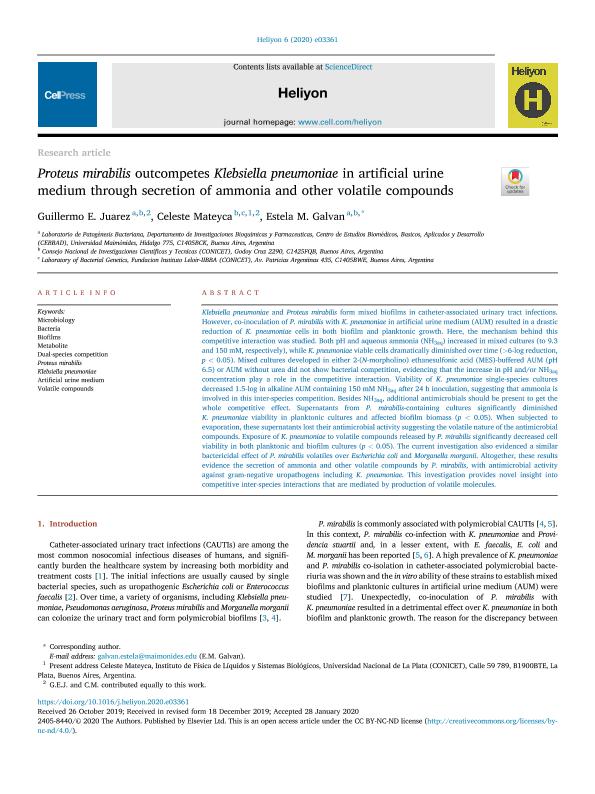Mostrar el registro sencillo del ítem
dc.contributor.author
Juarez, Guillermo Esteban

dc.contributor.author
Mateyca, Andrea Celeste

dc.contributor.author
Galvan, Estela Maria

dc.date.available
2021-04-29T15:52:30Z
dc.date.issued
2020-02
dc.identifier.citation
Juarez, Guillermo Esteban; Mateyca, Andrea Celeste; Galvan, Estela Maria; Proteus mirabilis outcompetes Klebsiella pneumoniae in artificial urine medium through secretion of ammonia and other volatile compounds; Elsevier; Heliyon; 6; 2; 2-2020; 1-9
dc.identifier.issn
2405-8440
dc.identifier.uri
http://hdl.handle.net/11336/131037
dc.description.abstract
Klebsiella pneumoniae and Proteus mirabilis form mixed biofilms in catheter-associated urinary tract infections. However, co-inoculation of P. mirabilis with K. pneumoniae in artificial urine medium (AUM) resulted in a drastic reduction of K. pneumoniae cells in both biofilm and planktonic growth. Here, the mechanism behind this competitive interaction was studied. Both pH and aqueous ammonia (NH3aq) increased in mixed cultures (to 9.3 and 150 mM, respectively), while K. pneumoniae viable cells dramatically diminished over time (>6-log reduction, p < 0.05). Mixed cultures developed in either 2-(N-morpholino) ethanesulfonic acid (MES)-buffered AUM (pH 6.5) or AUM without urea did not show bacterial competition, evidencing that the increase in pH and/or NH3aq concentration play a role in the competitive interaction. Viability of K. pneumoniae single-species cultures decreased 1.5-log in alkaline AUM containing 150 mM NH3aq after 24 h inoculation, suggesting that ammonia is involved in this inter-species competition. Besides NH3aq, additional antimicrobials should be present to get the whole competitive effect. Supernatants from P. mirabilis-containing cultures significantly diminished K. pneumoniae viability in planktonic cultures and affected biofilm biomass (p < 0.05). When subjected to evaporation, these supernatants lost their antimicrobial activity suggesting the volatile nature of the antimicrobial compounds. Exposure of K. pneumoniae to volatile compounds released by P. mirabilis significantly decreased cell viability in both planktonic and biofilm cultures (p < 0.05). The current investigation also evidenced a similar bactericidal effect of P. mirabilis volatiles over Escherichia coli and Morganella morganii. Altogether, these results evidence the secretion of ammonia and other volatile compounds by P. mirabilis, with antimicrobial activity against gram-negative uropathogens including K. pneumoniae. This investigation provides novel insight into competitive inter-species interactions that are mediated by production of volatile molecules.
dc.format
application/pdf
dc.language.iso
eng
dc.publisher
Elsevier

dc.rights
info:eu-repo/semantics/openAccess
dc.rights.uri
https://creativecommons.org/licenses/by-nc-nd/2.5/ar/
dc.subject
ARTIFICIAL URINE MEDIUM
dc.subject
BACTERIA
dc.subject
BIOFILMS
dc.subject
DUAL-SPECIES COMPETITION
dc.subject
KLEBSIELLA PNEUMONIAE
dc.subject
METABOLITE
dc.subject
MICROBIOLOGY
dc.subject
PROTEUS MIRABILIS
dc.subject
VOLATILE COMPOUNDS
dc.subject.classification
Biología Celular, Microbiología

dc.subject.classification
Ciencias Biológicas

dc.subject.classification
CIENCIAS NATURALES Y EXACTAS

dc.title
Proteus mirabilis outcompetes Klebsiella pneumoniae in artificial urine medium through secretion of ammonia and other volatile compounds
dc.type
info:eu-repo/semantics/article
dc.type
info:ar-repo/semantics/artículo
dc.type
info:eu-repo/semantics/publishedVersion
dc.date.updated
2021-04-23T19:07:10Z
dc.journal.volume
6
dc.journal.number
2
dc.journal.pagination
1-9
dc.journal.pais
Reino Unido

dc.description.fil
Fil: Juarez, Guillermo Esteban. Consejo Nacional de Investigaciones Científicas y Técnicas; Argentina. Universidad Maimónides. Centro de Estudios Biomédicos, Básicos, Aplicados y Desarrollo. Departamento de Ciencias Biológicas y Biomédicas; Argentina
dc.description.fil
Fil: Mateyca, Andrea Celeste. Consejo Nacional de Investigaciones Científicas y Técnicas. Oficina de Coordinación Administrativa Parque Centenario. Instituto de Investigaciones Bioquímicas de Buenos Aires. Fundación Instituto Leloir. Instituto de Investigaciones Bioquímicas de Buenos Aires; Argentina
dc.description.fil
Fil: Galvan, Estela Maria. Universidad Maimónides. Área de Investigaciones Biomédicas y Biotecnológicas. Centro de Estudios Biomédicos, Biotecnológicos, Ambientales y de Diagnóstico; Argentina. Consejo Nacional de Investigaciones Científicas y Técnicas; Argentina
dc.journal.title
Heliyon
dc.relation.alternativeid
info:eu-repo/semantics/altIdentifier/url/https://linkinghub.elsevier.com/retrieve/pii/S2405844020302061
dc.relation.alternativeid
info:eu-repo/semantics/altIdentifier/doi/https://doi.org/10.1016/j.heliyon.2020.e03361
Archivos asociados
